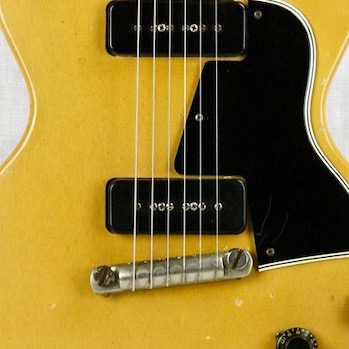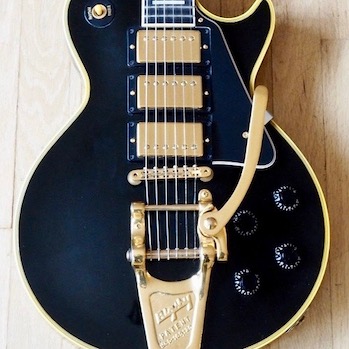With the advent of electrification, tuning was more important than ever for the amplified guitarist. Out of tune strings previously drown out by horn players suddenly became glaring. This magnified the age-old problem around intonation and compensation for wound and unwound strings. Up until 1953, guitars either had a wraparound bridge or a non-adjustable wooden bridge.


The problem with both of those options was that they offered little to no room for adjustment. Changing string gauges meant throwing off the intonation. Changing the action was only possible through truss rod wrangling or adjusting the bridge height as a whole.
The was no way to finely adjust the scale length for each string to dial in the proper intonation. Given different string gauges and tensions, different neck angles and imperfect nuts, this sweet spot can vary from instrument to instrument. Gibson president and guitar design visionary Ted McCarty saw an easy fix: create a bridge with individually adjustable saddles. So in 1952 he submitted the design for his so-called Tune-o-matic bridge for patent (US 2740313 A).

The Tune-o-matic (or TOM) bridge first appeared on the 1953 Gibson Super 400 and the 1954 Les Paul Custom. By the early 1960s, the design had made its way through most of the Gibson electric (and a few acoustic) models.
It’s hard to overstate just how giant of a leap forward the Tune-o-matic bridge was for guitar design. Today, some form of it is used by nearly every guitar manufacturer out there, large scale or boutique. The fact that very few changes have been made through the years is a testament to the TOM’s simple but effective design.
Before we get too high on singing its praises, let’s remember that owning and maintaining a TOM isn’t always a walk in the park. Here’s the skinny on sussing out vintage specimens, getting them back in line and potential upgrades.
Diagnosing Your Tune-o-matic
The first thing to do when looking at a used guitar with a TOM is to make sure all of the parts work. For such a small piece of equipment, the TOM has many moving parts, all of which are essential. Take, for instance, the retainer wire, which spans the adjustment screws to hold them down. If there is a retainer wire, you must make sure it is not loose or stretched.
Next, check that each saddle moves in both directions and that the adjustment screws are not stripped. Be sure all off the pieces fit tightly. Any rattle will result in a loss of contact and tone. If the bridge has roller saddles, make sure they move easily so that they will return to pitch normally.
For standard saddles, the notches must be smooth and clean. A common problem is that the saddles are not slotted deep enough. This causes the string to move and create its own irregular saddle. While this is fixable in most cases, you’ll need to be handy with a file. There are also replacement saddles for hot-rodding that we’ll address later.
Common Vintage Problems

If you are working on a vintage TOM, there is a whole host of other issues we haven’t touched. The most common problem with old TOMs is “bridge collapse." This happens to instruments left at pitch for very long periods, exacerbated by a low stop tail.
A stop tailpiece is a fixed metal bar anchored by two posts into the guitar body. The grab for the ball-end of your strings. Distance from bridge and its height are variable.
If the stop tail is too low and the strings contact the back of the bridge after going over the saddle, it will basically double the pressure of the strings on the bridge. This will cause the bridge to cave and change its radius, making for a less playable instrument.
Once the damage is done, you will need to replace the bridge. To prevent a collapse, there are two simple solutions:
- Raise the stop bar up enough to lift the strings from contacting the bridge.
- Top-wrap the stop bar—put the strings through the front of the bridge, and then come over the top.
Top-wrapping is a popular option with many players such as Joe Bonamassa, Billy Gibbons, and occasionally even Jimmy Page. Some say it adds tone and sustain, or that it makes the strings more slinky with the reduced tension.
While this may be the case, top-wrapping can also make the stop tail dive forward if you don’t have locking posts, which we’ll hit on later. Some use lighter gauge strings while some prefer the tension of a traditional stringing. It’s really all a matter of taste.
Setting Height and Intonation
Setting string height is one of the easiest parts of setting up a TOM, since the bridge is already set to the radius of the fretboard. Some models have screw-adjustable posts while others just have traditional thumbwheels. The thumbwheels are good for gross adjustment, but the screw posts are best for fine-tuning, if you have them.
Best practice is to slacken the strings when raising or lowering the TOM because the tension can add stress to the threads. If you have a locking TOM, make sure to unlock it during adjustments. Stew Mac makes a Bridge Jack (along with other TOM specific tools) which aids in lifting the bridge for faster adjustments. Do not use anything but your fingers to turn the thumb wheels, as the grips and plating deform easily.
When it comes to height on an electric guitar, there are no real right or wrong settings. General rules dictate you set it low enough so that it’s still easy to fret but with little to no buzz along the entire fretboard. Many tend to follow the standard, as described from Dan Erlewine, for electric guitars: action at the 12th fret is 0.078" on the low E and 0.063" on the high E.
Intonation was discussed in the previous installment of this series. Simply put, holding the tuned guitar vertically, as you would play it, sets you up to test the note at the 12th fret.
If the note is flat, move the string saddle forward until it’s in tune. If it’s sharp, move it back until it’s in tune. This will take a few adjustments to get it pitch-perfect. Most clip-on or pedal tuners will work. If you really want to get exact, you can invest in a heavy duty strobe tuner.
Hot-Rodding a Tune-o-matic
TOM bridges have numerous upgrades to make your guitar a higher performance machine, regardless of what you’re playing. A roller TOM is a popular upgrade, where the saddles are replaced with rollers to help your Bigsby stay in tune. Graph Tech also makes Teflon replacement saddles that eliminate string binding.
Many times these replacement saddles need to be notched, which can be tricky to do right without the knowledge or experience. This is an activity best performed by a professional at first. If the DIY bug has you, Stew Mac also made this great tutorial.
Quite a few companies also make entire TOM assemblies out of various materials with different properties. Titanium is a popular one. Replacement bridges range in price wildly, so make sure not to go overboard. All things considered, it might not be a good idea to put a $300 bridge on a $500 guitar. Babicz also makes a full contact version of the TOM that increases surface coupling with the instrument, although it is not as easily adjusted as a traditional TOM.
Finally, one of the best upgrades for your TOM is a set of locking posts. TonePros makes direct replacement locking studs which will fit with your stoptail and existing studs with no modification. TonePros also makes locking TOM bridges for direct replacement. These are very simple to install - about as fast as a string change.
Locking stoptail posts are essential for a guitar with a simple wraptail bridge. These bridges tend to lean forward on standard studs, and can raise action and kill sustain. If you’re upgrading to a wrap-around bridge that can be intonated, the stronger coupling will add back the sustain that is lost with more moving parts.
The Tune-o-matic is one of the few close-to-perfect inventions for electric instruments, but that doesn’t mean it can’t be improved upon. Although the design has aged well, a few simple tweaks can make it even better. Once you dial yours in, you can really just set it and forget it.
